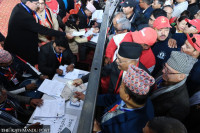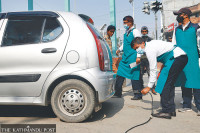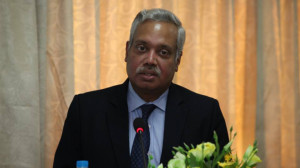National
Gen Z protests leave mandatory embossed number plates in limbo
Transport department says it won’t be able to provide the service for at least six months.
Post Report
Following the Gen Z protests of September 8 and 9, the government’s decision to make embossed number plates mandatory in all registered vehicles has been put on hold even before the announced policy could come into force.
General Manager Rajeev Pokharel of the Department of Transport Management says that the department will not be able to provide this service for at least another six months, as the entire system for installing embossed number plates and the plant that produced the plates were damaged in arson during the Gen Z revolt.
“We had already dispatched embossed number plates to the provincial offices, but as the entire system has been damaged, having only the plates is not enough to install them,” Pokharel told the Post.
The government had announced that all registered vehicles must carry embossed number plates from September 17, reviving a long-delayed plan first introduced in 2021.
Despite the government announcement to make the embossed number plates mandatory, Pokharel had told the Post that it is not mandatory to obtain it within a timeframe.
The service would be available from September 17 and implemented gradually, Pokharel had said.
Officials say that the system will digitise records, help improve traffic security, and align Nepal with global standards. But the decision has reignited public resistance over high costs, the use of English script instead of Devanagari, and inadequate technical preparations.
The decision to enforce the embossed number plates was taken as per the decision of a thematic committee meeting chaired by Devendra Dahal, then-minister for physical infrastructure and transport, on August 5.
From mid-September, transport offices across provinces were supposed to issue embossed number plates during vehicle registration, ownership transfer and renewal.
The embossed number plate project was initially rolled out in 2021, but full enforcement was stalled following public resistance and confusion.
The government's plan to replace the current number plates with embossed ones on all vehicles had sparked controversy. Like earlier, the debate has largely centred on the use of English language on the plates, their quality, and their high cost among others.
Transport expert Ashish Gajurel said that public opposition to the plan was natural since people were being asked to pay much more for number plates than they currently do. He added that the government had failed to clearly communicate the benefits of embossed number plates to the public, which had fuelled resistance. Gajurel also said that Devanagari script should be used on the plates.
“The public resentment stems from the difficulties people face in obtaining embossed number plates,” said Gajurel, who is also executive director at the Nepal Intermodal Transport Development Committee. “If the government can ensure a convenient and hassle-free process for acquiring them, the protest is likely to diminish.”
According to the transport department, Nepal is the only South Asian country yet to introduce embossed number plates. Globally, around 95 percent of countries have already adopted the system. One of the key points of controversy, however, is that the number plates are scripted in English.
Previously, the government had justified the use of English by citing the BBIN (Bangladesh, Bhutan, India, Nepal) agreement, arguing that uniformity was needed for cross-border transport which was a reason for adopting English plates instead of the Devanagari script, said Rup Narayan Bhattarai, former director general at the Department of Transport Management.
However, Bhutan has already withdrawn from the BBIN framework, and relations between Bangladesh and India have recently soured, raising further questions over the government’s rationale.
“If the government wishes, there is still room to use the Devanagari script on embossed number plates,” Bhattarai said.
An embossed number plate has camera-readable digits. It is also embedded with an RFID (radio-frequency identification) microchip.
Government officials claim that installing embossed number plates is also advantageous as the technology will help trace vehicles in cases of theft or disappearance or accident.
Krishna Pant, the official overseeing the transport sector at the Ministry of Physical Infrastructure and Transport, says that since the Department of Transport Management has already signed an agreement with the company printing the embossed number plates, the ministry cannot intervene in the matter until the contract expires.
Pant adds that the ministry’s role comes only when the contract period ends and a new contract needs to be awarded. “As the existing contract has already specified the terms, the full authority to decide whether or not to use Devanagari on embossed number plates lies with the Department of Transport Management,” Pant said.
The government’s plan to launch embossed number plates goes back a decade. The plan was included in the Three-Year Interim Plan 2007–2010, but it was put on the back burner due to a number of reasons like delays in conducting a proper study to roll out the project.
On May 30, 2016, the government tried to distribute embossed number plates to vehicles based on the provincial structure against the existing zonal format.
Later, on February 22, 2018, the Supreme Court issued an interim order to stop issuing embossed number plates. A single bench of then-chief justice Gopal Prasad Parajuli issued the interim order in response to a petition filed by environmentalist Bharat Basnet.
Basnet had demanded that the Devanagari font be used on the number plates. He argued that the chip on the number plates could be used for spying and called it a breach of national security.
But on December 13, 2019, the Supreme Court vacated its stay order paving the way for the resumption of embossed number plate distribution.




 10.12°C Kathmandu
10.12°C Kathmandu














